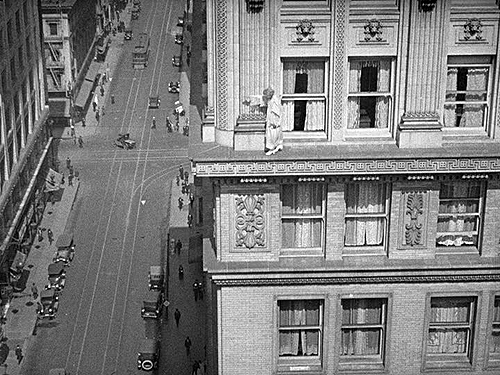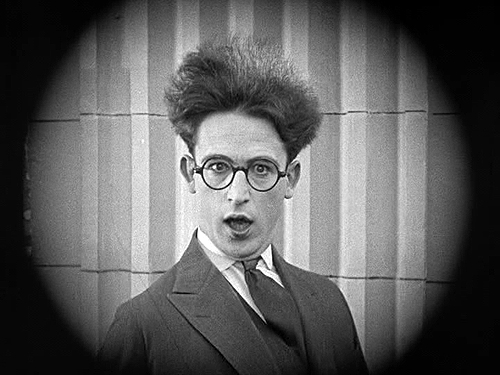This post is part of the Medicine in Movies Blogathon
hosted by Charlene’s (Mostly) Classic Movie Reviews
Harold Lloyd was one of the greatest, most successful and enduring silent comedians, and quite possibly was one of the greatest, most successful and enduring Hollywood stars of all time. I am a passionate fan of his work, and I am endlessly interested in the characters he created, his life, and the pioneering strides made by he and his contemporaries. So, despite my recent absence from writing, you will probably be seeing a lot more about Harold Lloyd here at Picture Show Girl (including tomorrow’s post on Dr. Jack (1922)).
Harold Lloyd’s 1920 short film High and Dizzy is probably the Lloyd short I’ve seen the most amount of times. This two-reeler is the second of Harold Lloyd’s famous “thrill pictures” – following 1919’s Look Out Below – and is seen by Lloyd scholars as a significant precursor to the Safety Last! (1923) climb sequence. It is also notable for how it places its leading lady in as much a thrilling situation as Lloyd, requiring of Mildred Davis the same derring-do as he. In High and Dizzy, Lloyd is a tipsy doctor – quite different from his wholesome later character, holistic Dr. Jack – and Davis is his sleepwalking patient.

When we are first introduced to Harold’s troublemaking doctor, he’s waiting impatiently for patients, smoking and playing cards. When someone inevitably walks into his empty waiting room, he executes a series of impressions to impress them, impersonating his fictional patients, and boasting the excellent treatments they have fictionally received at his practice. The most charming of these is the most absurd – Lloyd balances an anatomy head on top of his own, and covers his head with a large jacket as he limps in, a vision of surreality. It is clear that he is not the most conventional doctor, by any means – his unconventionality is a trait shared by his later doctoral character, Dr. Jack – but how else would a Lloyd character be, if not unconventional? Lloyd’s life was far from a conventional one, and the ways in which his on-screen persona responded to the situations around him were always creative, intelligent, and endearingly offbeat.

The Dr. seems all-too eager to operate – even on people who don’t need it. He is also all-too eager to flirt with his pretty potential patients – specifically, Mildred Davis, Lloyd’s to-be real-life bride. Harold was always a go-getter.
Once the chemistry between the two is established, Harold’s friend, portrayed by the Lloyd regular (and lifelong friend to the Lloyds) Roy Brooks, leads Harold to a stash of soon-to-be-expired prohibition backroom-brewed liquor, and hilarity ensues. I mean, what were they supposed to do? Let it all go to waste?

A series of slow-paced gags, featuring a very drunk Lloyd, is a pleasing play on the usual fast-paced, high-action Lloyd sequences he could do so well. It’s an interesting reversal of expectation and comedic pace to emphasise the drunk Harold’s delayed way of thinking and seeing. As we see, Lloyd’s humour works its magic at any pace. The gags still come fast enough, and have a real-world flavour – particularly the cringe comedy moments.
Soon enough, the completely unbelievable sneaks up on us. Davis, arm outstretched and eyes aglaze, wanders onto the window ledge in a sleepwalking trance in the middle of the day in the middle of a bustling city (apparently having slept in heels, glamorous footwear is thankfully sorted). Mildred was very frightened to perform this stunt, but with the bravery of the best classic slapstick dames, she harnessed some inner gusto and did the undoable. She doesn’t look the least bit scared – her ghostly gaze is absent and haunting – and her step is slow, deliberate, and steady. I can’t help but wonder if seeing her face the impossible head-on was the moment Harold Lloyd fell head-over-heels in love with Mildred Davis.

Harold follows her to the ledge. Soon enough, he is the one stuck, and she, the ethereal sleeping beauty, is safe inside. In his intoxicated stupor, it is not until it is almost too late that he realises the whole city is alive below. The sleepy pace thus far has suddenly changed. Lloyd, for the first time, is a man on a ledge.

One of Lloyd’s famous gags, the static hair trick communicating comedic shock, is reenacted here at the revelation that death lurks just centimetres from his feet. His hair, seemingly without any smoke and mirrors, stands up on end as Lloyd mugs to the camera. The strands then settle, then stand up on end again. He is high and dizzy, indeed.

Harold is trapped. He dances, he dangles, he clings for dear life, and it’s thrilling and shocking. Audiences must have been holding their breath with every step, gasping at every close call. It is this brilliance that Lloyd elaborates on and perfects in the Climb – something that audiences clearly engaged with, but that Harold didn’t particularly enjoy doing (he was afraid of heights). But he had to give them what they wanted, and push everything to the extreme – to the edge – of what was possible.

His work on the ledge is quite remarkable, given that his infamous accident occurred only mere months earlier – the one that obliterated the thumb and forefinger of his dominant hand, and temporarily blinded him – and his facial scarring below the lip (see below) is still very visible in close-ups from this time. (Perhaps his need to portray a doctor was partly due to his recent experiences? Perhaps it was his way of grappling with his traumatic injury; perhaps becoming a doctor was an attempt at healing himself?) I ponder how intense his drive was – his drive to prove to himself that he would not be held back by his handicap, and how perhaps it was that drive that pushed him to do superhuman things, like the Climb. To me, that is one of the most fascinating elements of Lloyd’s complex life and mind: his drive to be amazing, to be even better than he would have been without his flaws. He pushed himself out of what was known, what was safe, challenging what he could do, always expanding what could be done; always climbing.
I am reminded of a quote by Walter Kerr, author of The Silent Clowns (1975): “[Lloyd’s films] suggest that… rich American or poor American can overcome his beginning handicaps by nerving himself to the impossible.” Lloyd did just that.

Generally the wholesome, idealistic everyman, Harold Lloyd as a slightly deviant doctor is intriguing. It isn’t often he is in an authoritative position, which sets this apart, though he often doesn’t shy away from bending the rules in a lot of his other films, too. High and Dizzy Harold is far closer to a cheekily-pushing-the-boundaries, urban-dwelling Safety Last! (1923) or Speedy (1928) Harold than the more meek, reluctant Grandma’s Boy (1922), Girl Shy (1924) or Kid Brother (1927) Harold. It also differs to his Dr. Jack (1922); where Jack is also chock full of a Speedy-like spunkiness, he is a more tangible character, who is more interested in living life to the fullest than chasing the latest thrill. It is a misconception that Harold’s character is basically the same in each of his films. His array of characters closely resemble one-another at first glance, but there’s a hidden depth. The archetype he adopted was a cardboard cut-out upon which he could develop each incarnation’s nuances, projecting new hopes, aspirations, and dreams through those horn-rimmed spectacles. (I will certainly explore this in future Lloyd posts. I just adore him.)
In the world of slapstick comedy, doctors are just as prone to antics as anyone. In the world of silent comedy, an offbeat doctor can get unfortunately drunk during working hours on illegally-brewed liquor (a dissonant thought when applied to doctors in real life; I mean, who wants to acknowledge that our doctors may be real, flawed people?). However, seeing Harold as somewhat of a bad boy is part of High and Dizzy‘s charm. The film is effective, thrilling, and significant. And, if nothing else, ironic. Harold Lloyd was a lifetime teetotaller. he never drank alcohol. Although he did portray levels of drunkenness in a few of his films, I’m not sure if he ever experienced actually being drunk. He’s high – positively on top of the world – but not so dizzy.
The restored HD version of High and Dizzy is available on DVD and Blu-Ray from the Criterion Collection as an extra to the feature The Freshman (and I am lucky enough to own it! And it is beautiful!).
Pingback: Day 1 Recap – Medicine in the Movies Blogathon! | Charlene's (Mostly) Classic Movie Reviews
That scene on the ledge!! I’ve not seen this film and the images you’ve posted of Lloyd and Mildred on the ledge made me quite nervous. They are a couple of brave souls to do stunts like that!
This sounds like a great film. Thanks for the introduction. 🙂
LikeLike
Incredibly brave! 😊 Glad you enjoyed
LikeLiked by 1 person
Great post! I invite you to submit it to this week’s The Classic Movie Marathon Link Party. It ends tonight at midnight so if you miss this one, there is a new one each Monday night at 8 pm ET http://classicmovietreasures.com/classic-movie-marathon-link-party-10/
LikeLike
Sure I’d love to be involved!
LikeLike